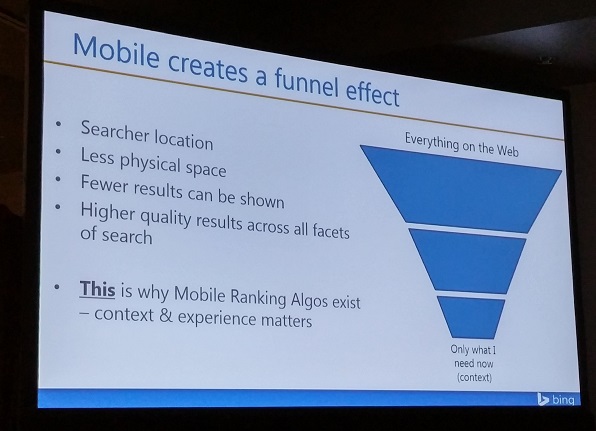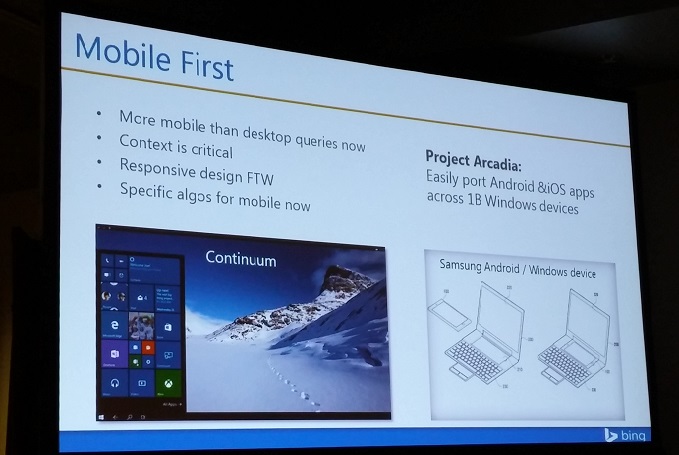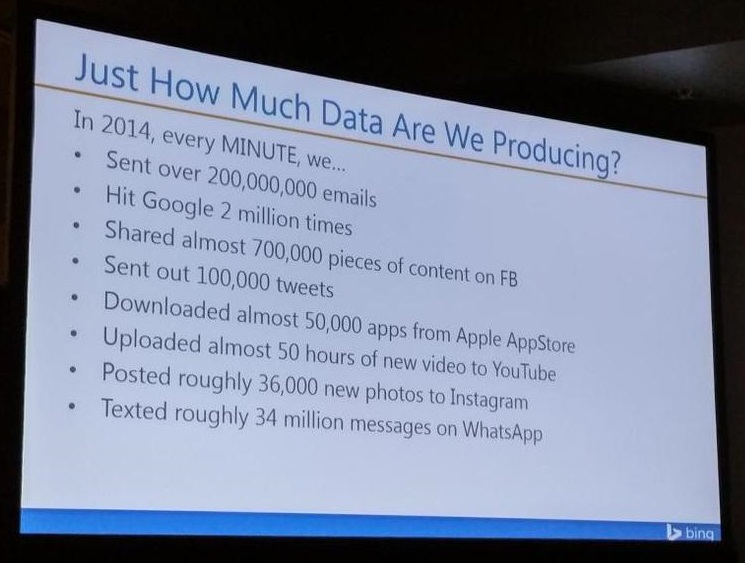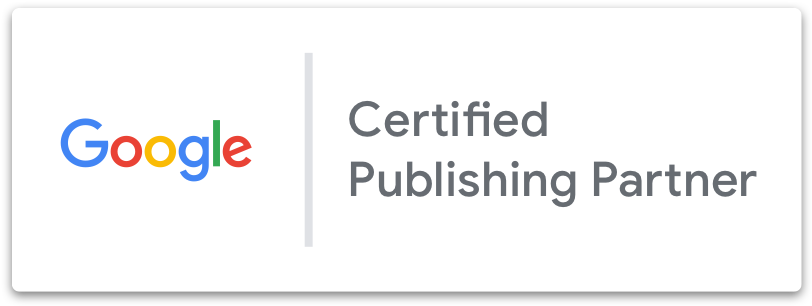Search is an ever-changing landscape of different variables that quantify what makes a website strong enough to rank. As we approach the end of 2015, some of us may be wondering what to expect in 2016 for SEO. My team had the opportunity to attend the Pubcon event in Vegas recently, and I’m happy to share what we learned in terms of the future of SEO.
A lot of businesses owners are still behind the times and are really going to feel it this coming year. If your business has yet to implement a responsive design, semantic markup, and a website that speaks to users, now is the time to implement those things. Otherwise, wait and fail because the future of search isn’t about the older demographic, but millennials and how they’re buying.
Focus on Mobile or Fail
We need to start looking at mobile optimization first since mobile search has finally reached a tipping point and has surpassed desktop search. Because of that, there are now mobile-specified algorithms that focus on mobile location and providing fewer results to the mobile user, but more qualified results than ever before.
As business owners and marketers, mobile optimization strategies need to speak to the mobile audience. This encompasses mobile voice search, mobile website design, mobile apps, and mobile website usability.
Optimizing for Mobile Voice Search
Traditionally, websites have been optimized for important key phrases because that’s how users would use a search engine. Now, with mobile voice search services such as Siri and Google Voice, users are approaching search in a different way. Google’s Hummingbird update directly speaks to voice search users, which allows the search engines to interpret full questions.
Instead of only optimizing websites with important keywords, start thinking about your audience and what questions they may be asking when your product or service will provide the solution. Simply adding a FAQs section to your website that answers these questions with well-researched answers would help optimize the site for voice search.
Optimizing Mobile App Traffic Sources
Since millennials are using their phones for more than just texting and searching Google, we need to be forward thinking when it comes to how they are searching within other apps. Social apps alone are a huge data source for search. Think about Pinterest. Have you searched for recipes on Pinterest? It has become its very own search engine. Therefore, businesses need to be optimized on social apps as well.
Optimizing Your Website for Mobile Users
When designing and optimizing a website, mobile design needs to be the first thought, since it’s where the majority of your traffic is going to come from. If it hasn’t happened already, it inevitably will happen soon. Optimizing the following website considerations will help provide a better mobile user experience:
- Optimize website speed times.
- Javascript, CSS, and image files should not be blocked from search engines.
- Use Schema.org structured data to enhance the rich snippets for mobile.
- Prevent the usage of pop-ups.
- DO NOT use any Flash, since mobile devices cannot read Flash.
- Make sure buttons and navigation are designed for big, fat fingers.
- Localize your footer with the correct Name, Address, and Phone Number for local search.
- Make sure the content reads well on mobile by optimizing headers and calls to action.
Use Responsive Design
Responsive design allows your website to scale to fit all devices seamlessly. There are still certain tweaks that need to be made to make sure the content is optimized correctly for mobile, but the website is pretty much the same on mobile as desktop, whereas mobile-specific sites may only show mobile users selected areas of your website, not the entirety of the site.
Include Schema Markup in Your On-Page SEO Strategy
Schema markup can enhance your presence in the search engine results by telling search engines exactly what your data means. When search engines understand what the data means, they can provide valuable rich snippets of your content right in the SERPs.
There are different schema markup types available for different content types, including: local, restaurants, products, reviews, recipes, ratings, events, articles, apps, and more. Implementing schema markup will help increase your website CTR, which can lead to higher rankings. We’ll talk more about that later. Take advantage of Google’s Structured Data Markup Helper to determine what schema to use for your site.
Optimize Content for Long Clicks
A valuable metric which I’m sure is overlooked by many is the average time on site and whether a user is bouncing off a specific page right away. Long clicks influence rankings, which was once a speculation but now is reality, per Rand Fishkin at Pubcon.
Answering Your Users’ Direct Questions
This can be done by having an interactive website with user-engaging content that walks visitors through the funnel, page by page. This also goes back to optimizing for voice search. Having a solution to a problem will help keep visitors on your site and engaged with your content longer. Directly speaking to your audience with your content is CRUCIAL!
Social Platform Sharing and Headline Optimization
How else can long clicks be established besides from the search results? Social signals can also be a huge advocate for creating long clicks on your blog posts and website content offers. For so long, we’ve been focused on the amount of shares, when in reality, it’s the amount of long clicks your content receives from social that will be the breadwinner in achieving higher rankings for that article you spent so much time on.
To do this, your headlines must match your content and be straight to the point. That way, users aren’t surprised when they click on your article to find that it is completely irrelevant to the title, causing them to bounce off.
Storytelling with Your Content
Instead of writing some plain, boring product description, use storytelling to explain that specific product and how it can relate to your consumer. Ask yourself this, if your content was removed from the web, would anyone miss it?
Be Creative with Your Link Building Strategies
In a recent blog post, we spoke about how you can create valuable content that will increase backlinks. This is the future of link building and what every site needs to have in order for high quality sites to link back to you. Other ways to generate quality backlinks include:
- Scraping competitor backlinks, sorting out low quality sites and going after high quality sites.
- Crawling competitor sites to find broken links. Now look at the links pointing to that page and outreach to those sites with your page that’s not broken.
- Discovering new sites by utilizing Twitter and other social platforms in your niche.
- Creating infographics that speak to your audience and share them until they go viral. Once your infographic goes viral, you will see the backlinks increase.
- Creating content on your site that speaks directly to a site you would like a link from.
Data, Data, Data: You Gotta Have It
The final important SEO factor for the future and now is accumulating as much data as you possibly can. At Pubcon, we learned that “data is the new oil.” It’s that important.
So, what kind of data should you be collecting? All of it.
Audience-Specific Data
Data-driven marketing starts with understanding the consumer and audience. Collecting this information up front is crucial to the content strategy, since you’ll want to know whether to tailor content to a specific gender, age group, geographic area, etc. Develop your ideal buyer persona based on current audience data, which can be collected from social platforms and Google Analytics.
Identify Patterns in Data Sets
Patterns tell a story with the data. There are different types of data that can provide different patterns. For example, when running a crawl report on your website, look for patterns in page types. Start by collecting the page data via crawl, identify footprints, and then sort/filter/pivot by page type. Page types can include: blog posts, archive pages, static pages, paginated comments, attachment pages, etc.
Once filtered, what do you see as the majority page type? If there’s a huge amount of a certain page type over all the other page types, chances are something is off technically with the site. You probably wouldn’t know that existed without identifying the pattern.
Other SEO patterns to be keep a lookout for may include:
- On-page link to content ratios
- Footer links with exact match keywords
- Off-site anchor text exact match percentages
- Duplicate pages and content
Use Custom Dimensions in Google Analytics
Understanding your audience can be two-fold: the buyer and the learner. In order to understand their separate ways of navigating through your site, you must use custom dimensions in Google Analytics. Once you’ve tagged a visitor as a buyer or learner, you will be able to identify patterns in how each user follows the funnel. This data is extremely important because you can better optimize for each audience, which will help increase your conversions.
Takeaways
In order to keep up with SEO, you must have these big factors in play. SEO is NOT dead, nor will it ever be dead. It’s just gotten a lot more complex. Basically if your website isn’t mobile friendly, has minimal content for users, and you’re not tracking your success, you will eventually fail. You can’t have a SEO plan without any of these factors in play. We’ll leave it with this closing quote from Pubcon:
“SEO success is adaptation. Data is critical to growth.” – Duane Forrester from Bing
If you’re overwhelmed by what goes into SEO today, don’t be. We are here to help. Give us a call.
Learn More About SEO Services
That Lay Out The Foundation For Any Online Marketing






